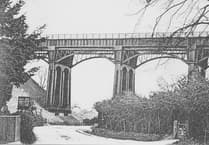The late-1930s brought about fundamental changes in the institutional care of the elderly and infirm in England – and two long-since demolished care homes in Farnham were at the forefront of this change.
St James’s – the first home in England to be purpose-built to serve the needs of the elderly – and St Andrew’s in the old workhouse buildings, demolished in 1966, both close to the modern-day Farnham Hospital in Hale Road, opened in July 1939 to considerable fanfare.
The revolutionary Surrey Council homes attracted councillors and other official visitors from far and wide to inspect the new concept, hailed at the time as “an outstanding sign of (a changed) administration of the Poor Law”.
Contemporary reports added: “The erection of a group of homes for the accommodation of 100 aged and infirm residents of good character was recognised to be necessary in conditions very different from the century-old workhouses.”
The old workhouse and infirmary were the last desperate resort of the destitute and sick, as lamented in the writing of 19th-century Farnham chronicler George Sturt.
Surrey workhouses underwent repairs and improvements in the latter part of the 19th century, but the original fabric dated back to the years following the Battle of Waterloo.
The new Farnham homes stood for the breaking up of Poor Law, the introduction of old age pensions, unemployment benefit, and the conversion of infirmaries into public health hospitals.
The contract for building the new homes went to Crosby and Co Ltd - later Crosby Doors - a well-respected local building company.
Mr Percy Crosby himself took a personal interest in the work, and the result was a prestige building for a total cost of £33,831, which included the house built for the officer in charge. Fixtures and fittings added £1,565 to the bill.
The rate of pay for craftsmen was 1/8d per hour - but to earn this high rate of pay, every craftsman had to prove his skills in every practical way.
All of the joinery – windows, doors, stairs, flooring, the flagpole and louvred cupola – were made at the Crosby joinery shop, then by the side of the river at Gostrey Meadow. Most of the flooring was of English oak.
The building was a credit to those bygone craftsmen, some of whom were cared for in later years in the home they helped to build.
Attractive bungalow-type units replaced grim and often barrack-like buildings. And the old people were now referred to as residents and not inmates as before. Staff were no longer required to wear prison-type uniforms.
Some years later, St James’ first matron Mrs Lily Banks told the Herald: “Compared with the institution, the new home was like paradise for the old people.
“They used to be so comfy with coal fires in their sitting rooms.”
Lily added the old men would sit outside in the spring, among the bluebells under the apple trees, smoking their pipes of shag tobacco.

St James’ also introduced occupational therapy, and the old ladies were encouraged to knit socks during the war.
Lily recalled that an innovation at the new homes was the introduction of single rooms and double rooms for couples - replacing the crowded wards of old.
The annual garden party was a special occasion at St James’s. Singer Jessie Matthews, who at one time lived in Farnham, opened one of these iconic garden parties in the 1950s, and ‘wide boy’ comic Arthur English, whose home was in Aldershot, did the honours in 1985.
The 1989 garden party was an important part of the golden jubilee celebrations - but soon afterwards, St James’s closed.
The once state-of-the-art home was deemed unsuited to modern needs and uneconomic to run, and residents were moved to a new purpose-built home in Merrow because there were no places for them in Farnham.
Surrey County Council continued to operate care homes in Farnham until 2016 and the closure of Cobgates in Falkner Road.





.png?width=209&height=140&crop=209:145,smart&quality=75)
